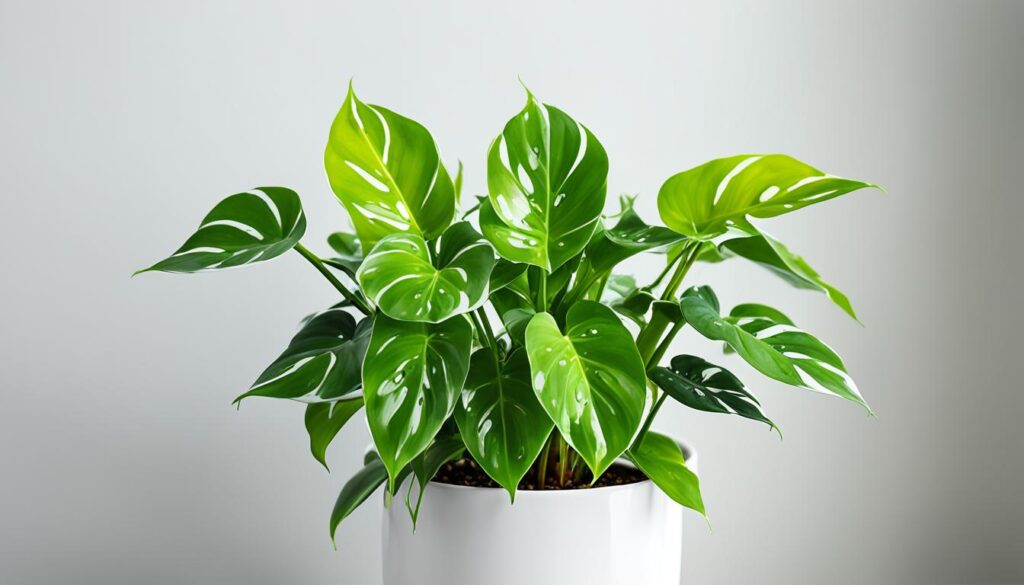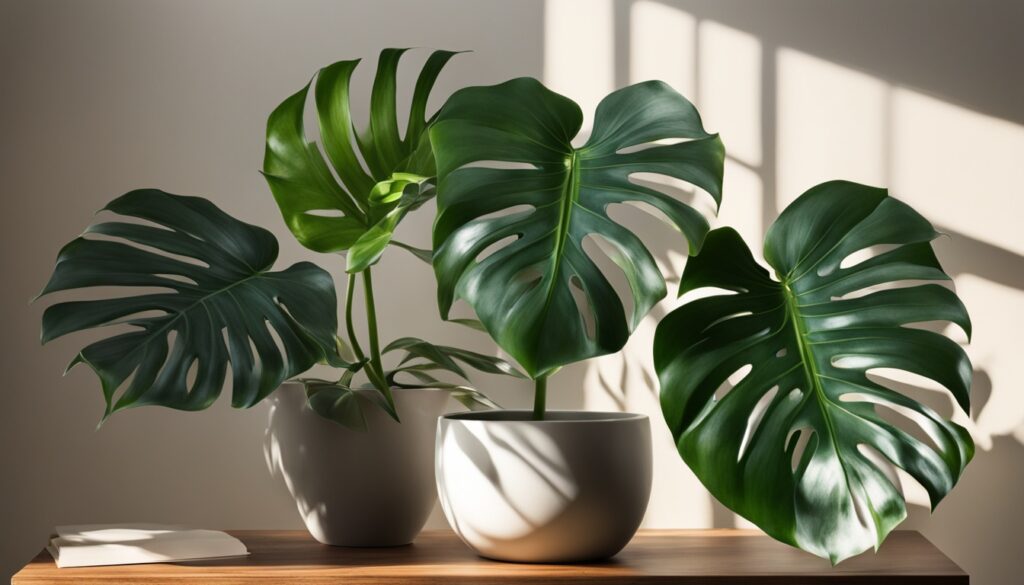The split-leaf philodendron is very popular, found in many homes and offices in America. It’s a lovely plant but needs special care to do well. We’ll go over how to take care of it, including the best light, water, and temperature, what kind of soil it likes, how to plant and replant it, and ways to make new plants. We’ll also cover how to trim it, what to do if it gets sick, and tips for using it in your home.
Key Takeaways:
- The split-leaf philodendron, also known as the Thaumatophyllum bipinnatifidum, is a member of the Araceae family and native to South America.
- These plants can reach heights of up to 6 feet indoors and 10 feet in their natural habitat, with leaves that can grow over 3 feet long.
- Split-leaf philodendrons prefer bright, indirect light and well-draining, nutrient-rich potting mix to thrive.
- Proper watering, temperature, and humidity levels are crucial for maintaining healthy, vibrant foliage.
- Propagation through stem cuttings or air layering is a reliable way to create new split-leaf philodendron plants.
Identifying the Split Leaf Philodendron
The split leaf philodendron is a known indoor and outdoor plant. It’s also called Thaumatophyllum bipinnatifidum or philodendron selloum. It looks beautiful with its tropical vibe. But, its name has changed a few times. This has made some confusion among plant enthusiasts.
Understanding the Botanical Confusion
At first, the split leaf philodendron was named in the Philodendron group. So, it was known as Philodendron bipinnatifidum or Philodendron selloum. However, in 2018, scientists decided it needed its own category. They renamed it to Thaumatophyllum bipinnatifidum.
Distinguishing from Monstera Deliciosa
The split leaf philodendron looks a lot like the Monstera deliciosa or Swiss cheese plant. They both have unique split leaves. Yet, the philodendron has more cuts in its leaves, making them look like fingers. The Monstera has rounder holes in comparison.
Native Habitat and Natural History
This plant hails from South America‘s tropical parts. There, it loves warm, damp rainforests. In the wild, it can get huge, reaching over 10 feet high and wide. But as a houseplant, it usually stays around 6 feet because the growth areas are smaller.
Caring for Split Leaf Philodendron
Keeping your split leaf philodendron healthy means finding the best spot for it. They love bright, indirect light. A little direct sun in the morning is okay, but keep them away from strong afternoon sun. This prevents their leaves from getting burnt. If inside, put yours in front of an east- or south-facing window. A sheer curtain can help filter the sunlight.
Lighting Requirements
Split leaf philodendrons do best with bright indirect or filtered light but can manage in medium light too. It’s key to their health and look to get the right light.
Watering Needs
When it’s time to water, keep the soil moist but not soaked. Check the top 2-2.5 inches of soil for dryness. Water when it’s dry there. Split leaf philodendrons can handle a little dry spell, so don’t over-water them.
Temperature and Humidity Preferences
The best temperatures for your split leaf philodendron are between 70 and 85 degrees in the day, and 65 to 70 at night. They also like the humid atmosphere, with levels over 40% ideal. This is often naturally maintained in homes.
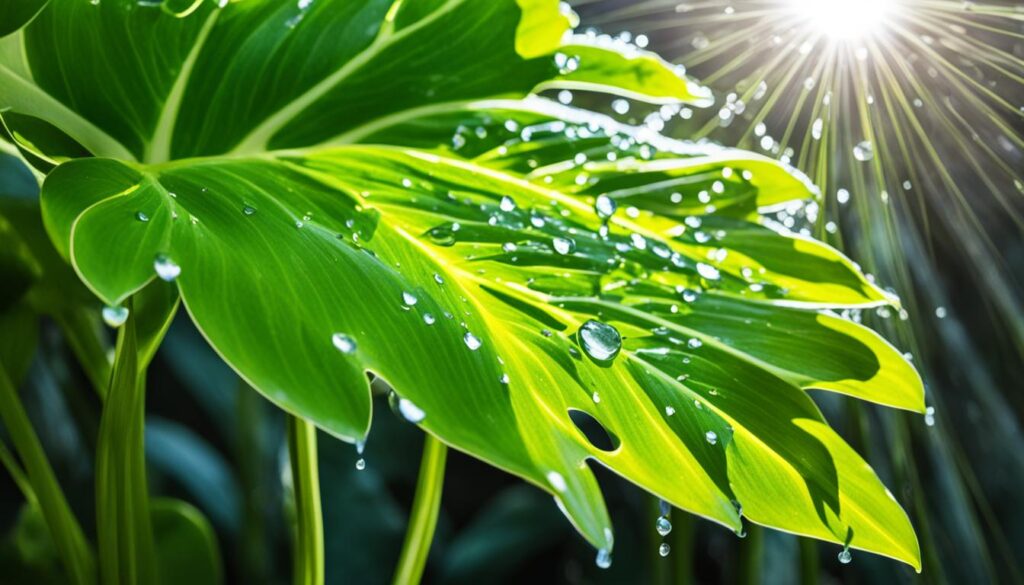
Soil and Fertilizer Requirements
To keep your split leaf philodendron healthy, it’s vital to use the right soil and fertilizer. These plants like soil that drains well and is full of nutrients. Mix a potting mix with peat moss. This mix keeps just enough moisture for the plant.
For split leaf philodendron fertilizer, use a balanced one that releases nutrients slowly. Apply it every 4-6 weeks when the plant grows, and it will stay strong and its leaves will be colorful. Avoid heavy soils that can block water and air or cause root rot.
| Soil Requirement | Fertilizer Recommendation |
|---|---|
| Well-draining, nutrient-rich potting mix with peat moss | Balanced, slow-release formula applied every 4-6 weeks during growing season |
With the correct split leaf philodendron soil and split leaf philodendron fertilizer, your plant will grow well. It will show off its beautiful, large lobed leaves in your home or garden.
Potting and Repotting Your Plant
When you buy a split-leaf philodendron, keep it in its pot at first. This helps the roots get settled. When you do repot it, pick a pot that’s much wider. A big enough pot means the plant can grow well.
Choosing the Right Pot Size
For your split leaf philodendron potting, choose a pot 1-2 inches bigger than the last. This gives the plant space without limiting growth. Use terracotta or similar pots for good air flow. This stops the soil from getting too wet.
Repotting Techniques
For split leaf philodendron repotting, use a mix that drains well. Adding materials like perlite helps with draining. Make sure the soil is just a bit acidic, which is what the plant likes.
When repotting, take the plant out carefully and loosen the roots. Cut the root ball from top to bottom in four places. This makes sure new roots will grow well. Put it in a bigger pot and cover it with soil. Water it well so the plant likes its new space.
Water more often right after repotting to help the plant adjust. Don’t plant it too deep or in a pot with bad drainage. This could harm the roots. Keep the soil moist but not wet.
Keep the plant out of direct sunlight for a few weeks after repotting. Also, make sure the plant is in a warm, stable spot. Big temperature changes can stress the plant.
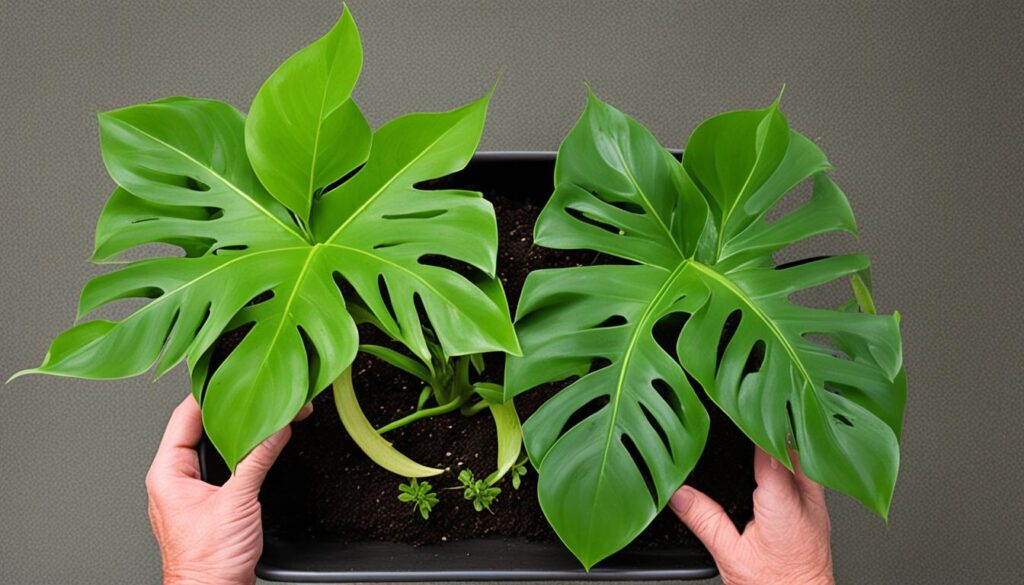
Remember to repot your split-leaf philodendron every 2-3 years. Look for wilted leaves as a sign it might need a new pot. Moving it in early summer helps it recover and grow better.
Propagating Split Leaf Philodendrons
Split-leaf philodendrons can be grown in a few different ways. One way is from seeds, but it’s hard and slow. An easier way is air layering or using stem cuttings.
Seed Propagation
Growing them from seeds is a bit challenging. Seeds need just the right warmth and moisture to sprout. It takes time and effort, but you’ll get unique plants this way.
Air Layering Method
Air layering is a good choice for split leaf philodendrons. It works by making roots on a stem piece, then planting that piece. This method often works better than just using a cutting.
Stem Cutting Propagation
Another easy method is using cuttings. You pick a healthy stem and put it in soil after treating it. This plant will soon grow its own roots and become a new one.
For any method you choose, keep the right conditions for your plants. This means the right humidity, temperature, and light. With care and time, you’ll have more of these beautiful plants.
Pruning and Grooming Your Plant
Pruning and grooming your split-leaf philodendron is key to its beauty. Use sharp shears to snip off dead or discolored leaves. This keeps your plant looking fresh and promotes new growth.
Remember, when you prune, keep the plant’s shape in mind. Don’t cut too much. Just remove what’s needed for a tropical, green look. Also, tidy up often by getting rid of old, yellow, or torn leaves for its best appearance.
These pruning and grooming methods are easy to do. They help your philodendron shine, inside or out, year after year.
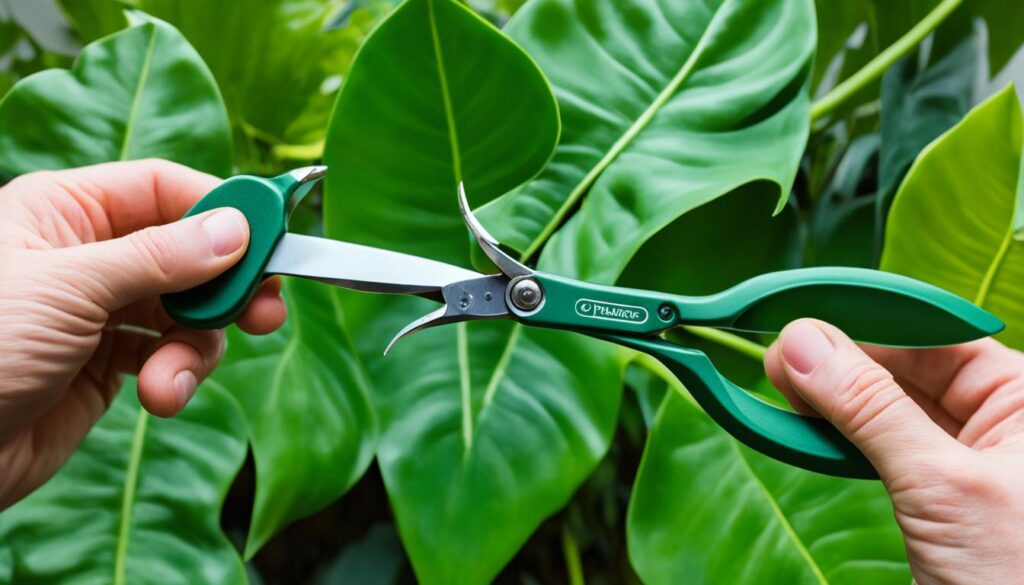
How to Care for Split Leaf Philodendron
The main thing in keeping a split leaf philodendron healthy is the right place. Choose a spot that gets bright, but not direct sunlight. Don’t let the plant get too dried out.
Understanding the needs for light, water, warmth, and moisture is essential for split leaf philodendron care. By knowing and meeting these needs, your plant will grow beautifully.
| Care Aspect | Recommended Conditions |
|---|---|
| Lighting | Bright, indirect light |
| Watering | Water when top 1-2 inches of soil are dry |
| Temperature | 65-85°F (18-29°C) |
| Humidity | Moderate to high (50-80%) |
Giving your split leaf philodendron the best care and environment is key. This way, it will stay healthy, grow well, and show off its leaves for a long time.
Common Issues and Solutions
Split leaf philodendrons are usually easy to care for, but they can face some issues. It’s important to take good care of them and watch out for problems to keep them healthy.
Yellowing Leaves
If the leaves of your split leaf philodendron turn yellow, you might be overwatering. Let the soil dry out before you water again. Plants can get sick if their roots stay wet. But, if you don’t water enough, the leaves might also turn yellow or curl. Finding the right amount of water is key.
Pest Infestations
Spider mites, mealybugs, and aphids can bother your philodendron. Check the plant often for these pests. Use organic insecticidal soap or neem oil to stop the pests.
Drooping or Curling Leaves
If leaves droop, curl, or look like they’re in a cup, it might not like its home. Make sure it has enough light, water, and humidity. Fix these things to make your plant look healthy again.
| Issue | Possible Cause | Solution |
|---|---|---|
| Yellowing leaves | Overwatering or underwatering | Allow soil to dry out between waterings; adjust watering frequency |
| Pest infestations | Spider mites, mealybugs, aphids | Treat with organic insecticidal soap or neem oil |
| Drooping or curling leaves | Insufficient light, water, or humidity | Provide brighter, indirect light; adjust watering and misting schedule |
Handling these issues fast will help your split leaf philodendron stay beautiful.
Decorating with Split Leaf Philodendrons
The split-leaf philodendron is known for its big, impressive leaves. It makes any indoor or outdoor space more beautiful. Inside, it’s great for making rooms look tropical. And outside, it stands out in gardens or on walls.
This plant has large, unique leaves and grows tall. It catches the eye wherever placed. Set it near a sunny window or on a patio. This will add beauty to your space, indoors or out.
To create a tropical-themed room, use other leafy plants with the split-leaf philodendron. Add wooden items, woven things, and bright colors to highlight the plant. Outside, use it in shade or as a main plant in the garden.
| Interior Design Ideas | Outdoor Landscaping Tips |
|---|---|
|
|
“The split-leaf philodendron’s dramatic foliage makes it a stunning addition to any indoor or outdoor space.”
No matter where you put it, the split-leaf philodendron stands out. It adds a bold, tropical look to your spaces. Plus, it’s easy to care for, making it a great choice for home and garden beautification.
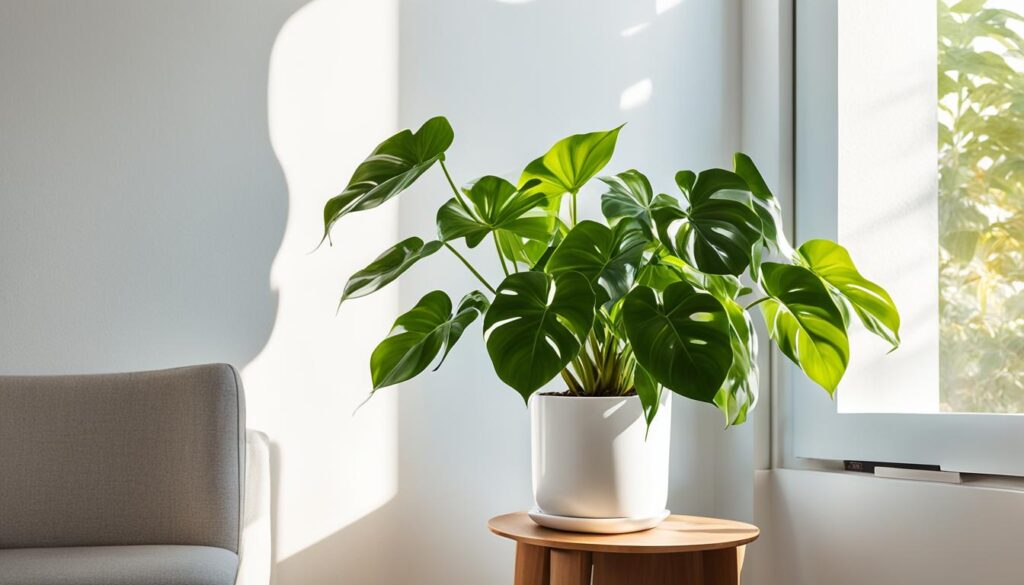
Conclusion
The split leaf philodendron is an eye-catching plant that’s easy to care for. It thrives both inside and out. Just give it the right light, water, temperature, and soil.
This guide is for anyone who loves plants, whether you’re just starting or you’re a pro. You’ve learned everything from how to spot your split leaf philodendron to how to care for its unique needs. Plus, you know how to solve any problems and incorporate it into your home’s decor. Now, you’re set to grow a beautiful split leaf philodendron.
With enough care, your split leaf philodendron will become a favorite part of your home. It will last for years and show you the amazing variety in nature. Stick to the advice here, and you’ll be a split leaf philodendron pro in no time. Enjoy your plant journey!
